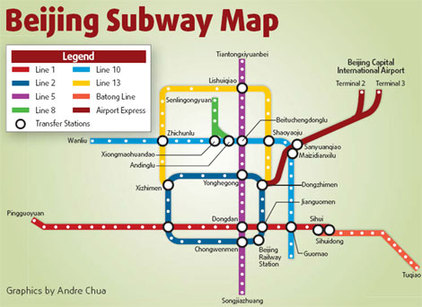
Beijing's bigger and better subway system has been a long time incoming. But like everything in China, its rate of growth in the past year has been phenomenal.
Four new lines and about 50 new stations opened over the past year in the lead up to the Games. By the middle of the next decade, the Beijing subway will become the world's largest and play a key role in taking cars off the city's roads.
From 2002 the city invested more than $7.69 billion on the new subway system. By 2015 there are plans for 19 lines in total and 561 km of track linking almost every part of the city.
When completed, this massive network of tracks and stations will surpass London's 415 km of subway and New York's 371 km.
Beijing was the first city on the mainland to build a subway and planning began in the early 1960s. Construction began in 1965 and the subway was finally opened on China's National Day in 1969.
The first line ran 21 km from the army barracks in the Western Hills to the Beijing Railway Station. This line forms the basis for parts of today's Lines 1 and 2, which includes the stop at Tian'anmen Square.
In 2001, the city won the bid to host the 2008 Summer Olympic Games and officials accelerated plans to expand the subway. The next additions were surface commuter lines that ran to the north and east of the city. Line 13 was a half loop that links the northern suburbs, first opened in 2002.
The Batong line became an extension to Line 1 and was opened as a separate line in 2003. As more lines were laid, more commuters went underground. There were more than 607 million subway rides in 2004.
Three years later, No 5 came alive making it the city's first north-south line.
Last month, three new links (Line 10, the Olympic line and Airport line) opened to increase the number of subway lines in the Chinese capital to eight.
The total length of track is now 200 km. The use of paper tickets, hand checked by clerks for 38 years, was discontinued in June this year and replaced by electronic tickets that are scanned by automatic fare collection machines.
And to encourage more commuting, the price to ride the subway was slashed to 2 yuan (27 US cents).
Local Beijingers are praising the new lines because the system saves time. Some commuters, living beyond the 5th Ring Road, are saving more than two hours a day in travel time.
The low-cost and high-speed subway ride will also encourage more people to commute, taking cars off the road helping to alleviate the city's infamous traffic jams and improve the environment.
(China Daily August 4, 2008)